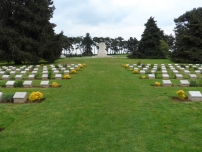| First Name: | Alfred George | Last Name: | COX | |
|---|---|---|---|---|
| Date of Death: | 09/08/1915 | Lived/Born In: | Dulwich | |
| Rank: | Sapper | Unit: | Royal Engineers 67th Field Company | |
| Memorial Site: | ||||
Current Information:Age-17 15, Matham Grove, East Dulwich Green Hill Cemetery, Gallipoli
Gallipoli 1915 On 25 April, British, Australian and New Zealand forces landed on the Gallipoli peninsula. The plan was that these forces would soon defeat a demoralised Turkish army, knock Turkey out of the war, open up the Mediterranean to the Russian navy and threaten Austro-Hungary from the south. None of these things were achieved despite nine months of hard fighting in terrible conditions. It was a heroic failure. By July, 1915, and after much fierce fighting, stalemate had set in at Gallipoli both at Cape Helles where the British and French had landed and at Anzac Cove where the Australian and New Zealand Corps were unable to break out of their beach head. Fresh troops were needed and they were on their way in the shape of four divisions from Britain and things were put on hold until they arrived. The plan for August was for a landing at Suvla Bay to the north of Anzac Cove whilst at the same time, the ANZAC Corps, reinforced by some of the new British troops would effect a breakout from Anzac Cove and establish a line across the peninsula. Whilst this was going on the troops in the south at Helles would stage a number of diversionary attacks. But it all went horribly wrong and much of the reason for this can be explained by inadequate planning and leadership. Nobody seemed to know what they were supposed to be doing and Lieutenant-General Stopford, in charge of the Suvla landings was particularly out of his depth. The landings at Suvla failed to link up with the forces at Anzac and the breakout from there did not happen despite valiant efforts by all concerned. The loss of life on all fronts was again enormous. L.A. Carlyon’s excellent book “Gallipoli” gives a superb yet chilling account of the events. During the night of 6/7th August, 11th Division landed at Suvla when 32 and 33 Brigades came ashore on B Beach, south of Nibrunesi Point. The beach was undefended but due to a mix-up in the landings, with units finding themselves in the wrong positions and a lack of any decisive leadership, a great deal of confusion reigned for the next 36 hours. Eventually got moving and reorganised by the morning of 8th August, 32 Brigade began an advance to the line Sulajik-Anafarta Ova when 9th West Yorkshire and 6th Yorkshire, occupied Scimitar Hill without meeting serious opposition. If 32 Brigade had then pushed on, W Hills (Ismail Oglu Tepe), a position of prime importance, could have been taken as Turkish reinforcements had still not arrived. But this advantageous situation had changed by the next day, 9th August, when 6th East Yorkshire, the pioneer battalion of 11th Division and the 67th Field Company of the Royal Engineers advanced on Tekke Tepe, the ridge of hills to the east of Suvla Bay. They met little opposition at first but because of the extreme exhaustion of the men, progress was slow. They made their way up the slopes where they met fierce machine-gun and rifle fire from in front, the flanks and even from behind coming from concealed enemy trenches. They suffered heavily and only a few made it back to their starting positions near Sulajik. Among the casualties was Alfred Cox. |
||||
| « Back to Search Results | ||||
| If you think any of the information shown here is incorrect, Click Here to submit your amends and comments | ||||




